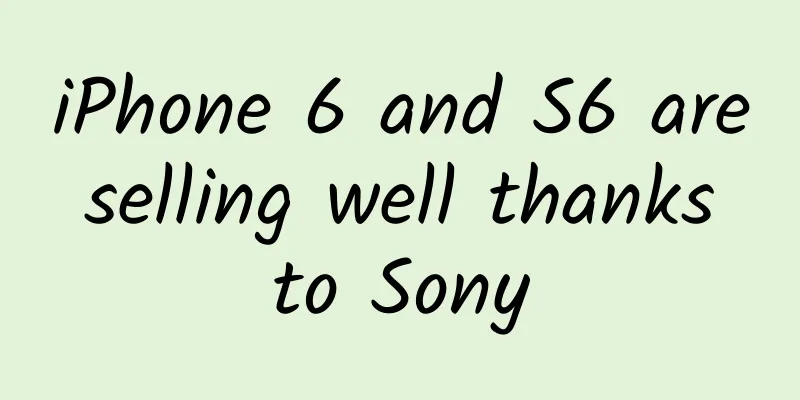iPhone 6 and S6 are selling well thanks to Sony

|
Sony may have lost the smartphone war, but the Japanese electronics giant is getting a piece of the action as sales of Apple's iPhone 6 and Samsung's Galaxy S6 soar. The reason is that Sony is the world's largest supplier of digital imaging sensors. In order to meet the growing demand, Sony recently announced an additional investment of $375 million in imaging sensor factories, following the $900 million it announced earlier this year. "Whether it's used in other manufacturers' products or in our own devices, I'm excited as long as we can achieve innovation," said Kazuo Hirai, president and CEO of Sony. Sony once dominated the global electronics industry for decades with its semiconductor radios, CDs and Walkmans, but times have changed. Under the leadership of 54-year-old Kazuo Hirai and CFO Kenichiro Yoshida, the Japanese company no longer hopes to regain its former glory and launch epoch-making consumer electronics products. Instead, Sony hopes to bolster its own profitability through innovations from other companies, most notably Apple's iPhone 6. Analysts say each iPhone 6 contains two Sony imaging sensors and other related components, generating $20 in revenue for the device. Early iPhones had only one sensor, but the popularity of selfies has helped Sony's market dominance. As the strategic transformation has begun to bear fruit, Sony's long-slumping stock price has doubled in the past year. Sony will release its latest financial report on Thursday. The company originally expected to achieve an operating profit of 20 billion US dollars in the fiscal year ending March 31, and just last week it raised its forecast to 68 billion yen (about 571.9 million US dollars). Sony is expected to post its sixth annual net loss in seven years due to asset write-downs in its smartphone business. In addition, Sony will suspend dividends for the first time since its listing in 1958, and its long-term debt rating was downgraded by Standard & Poor's last year, just one step away from "junk level". Sony is facing so many difficulties in the consumer electronics industry that Hirai no longer uses the word "revival". The company plans to achieve an operating profit of at least 500 billion yen in fiscal 2017, with nearly half of that coming from its imaging sensor and video game businesses. "If we talk about Sony as a whole and our strategy, and how we're going to grow over the next two to three years, I do think we're starting to turn the corner," Hirai said. In February this year, Sony reorganized its businesses into three levels based on growth prospects and investment priorities. The first level is imaging sensors, video games, movies and music, the second level is cameras, video and audio equipment, and the third level is smartphones and TVs. That puts imaging sensors on par with the best-selling PlayStation 4 game console, which sold more than 20 million units in March, far outsold Microsoft Corp.’s Xbox One. Sony has already spun off its PC business, and Hirai is considering selling its TV and smartphone businesses. Yoshida is in charge of a cost-cutting plan that aims to reduce headquarters costs by 30 percent from fiscal 2013 levels. Get rid of traditional impressions "We should keep pace with the times and no longer view Sony as a mere consumer electronics manufacturer," said Uchihiro Uchihiro, associate professor at Waseda Business School and former head of product strategy at Sony. However, this unconventional approach has caused dissatisfaction among Sony's veteran engineers, who have always seen themselves as the elite of Japan's high-tech industry. "Many outstanding scientists have left Sony," said Junichi Hasegawa, a former PlayStation engineer who left Sony five years ago. Sony still has a long way to go. Despite a recent rebound, the stock is still down more than 70% from its peak in 2000. Sony expects sales in its most recent fiscal year to be less than half of Apple's revenue in 2014. Meanwhile, the company's Sony Pictures unit is still recovering from last year's hack. Amy Pascal, who has led Sony Pictures for more than a decade, will leave in May to become co-chairman of the company. Panasonic and NEC have also adjusted their strategies, transforming from consumer electronics manufacturers to component suppliers. This also reflects to a certain extent that Japanese manufacturers attach importance to profits and no longer blindly pursue market share. Hirai said Sony is not prepared to completely abandon some of its consumer electronics businesses that still perform well, including high-end audio and ultra-high-resolution projectors, and he is also interested in products such as digital cameras. However, even in video games, a traditional strength, Sony is quietly changing direction. Analysts say the most promising growth point for PlayStation in the future is the accompanying digital network, which allows the company to sell online games, movies, music, television and other content, mostly from outside suppliers. Imaging sensors are an important part of Sony's reorganization. The company has four imaging sensor factories in Japan, one in Kumamoto on Kyushu Island. Although the outside of the factory is a pastoral scene, inside, you can see busy robots producing chips everywhere. Obvious technical advantages Few iPhone or Galaxy users know that their smartphones have some parts from Sony. The company's latest image sensor, the Exmor RSIMX230, can achieve a resolution of 21 megapixels. Sony says it is also the first smartphone imaging sensor to borrow autofocus technology from high-end cameras, making it easier for users to capture fast-moving objects. Sony has many years of experience in developing imaging sensors, which mainly stems from the company's deep roots in the field of photographic equipment. "We have accumulated technology for a long time," said Tetsuo Nomoto, head of Sony's imaging sensor business. In 2012, Sony made a technological leap and developed a new chip that is equivalent to stacking two chips the size of a fingernail on top of each other. One chip is used to capture graphic pixels, and the other contains the sensor circuit. This approach can help smartphone manufacturers produce thinner phones. Analysts said that although OmniVision is a competitor of Sony in the field of image sensors, it has not been able to mass-produce stacked image sensors. OmniVision declined to comment. UBS analyst Ryosuke Katsura said the high-quality imaging technology had become a Sony trade secret. Analysts believe that, at least for now, Sony is the only imaging sensor maker that can meet the needs of high-end smartphone makers, and even Samsung cannot produce comparable products. Samsung declined to comment. "Unlike memory chips, imaging sensors require sophisticated craftsmanship, so competitors won't be able to imitate them anytime soon," said Hideaki Miwa, an analyst at Techno Systems Research. According to Techno Systems Research, Sony's global image sensor market share last year was as high as 40%, higher than 35% in 2013. OmniVision's share was only 16%, and Samsung's was 15%. Last year, global image sensor sales reached $8.65 billion, an increase of more than 80% from 2009. Some analysts believe that keeping up with market demand may be Sony's biggest challenge in the short term. In the long run, Sony's performance is vulnerable to shocks due to its over-reliance on Apple, which sometimes suddenly changes suppliers. Satoru Oyama, a semiconductor analyst at market research firm IHS, said Apple might consider purchasing imaging sensors for the iPhone from other sources if other companies could match Sony's quality and price. "Sony's position can be maintained for at least a few years, but what will happen in five years? No one can guarantee it," he said. Apple declined to comment. To avoid over-reliance on Apple, Sony has begun marketing its own imaging sensors to low-cost Chinese smartphone makers such as Xiaomi. These sensors can also be used in self-driving technology, which is expected to create a new source of growth for Sony. Explore income sources At the same time, Sony is also looking to create new revenue streams for its oldest and most reliable cash cow, video games. PlayStation game consoles are highly cyclical, and sales tend to surge in a short period of time when new models are launched. Some analysts believe that with the rise of smartphone games, the long-term prospects of home game consoles are worrying. But Sony disagrees. In November last year, the company forecast that its video game revenue would reach 1.4 trillion to 1.6 trillion yen in fiscal 2017, and 1.38 trillion yen in the fiscal year ending March this year. Sony raised its revenue forecast again in February this year. Andrew House, CEO of Sony Computer Entertainment, said most of the growth came from Sony's entertainment network, a paid service that is providing more and more features to users. He hopes to redefine the PlayStation platform. The business, which House leads, recently added music from Spotify and movies from Netflix. TV shows are available in parts of the U.S. on a new service called PlayStation Vue, and in March, Sony released “Powers,” the first TV series made specifically for the PlayStation. "Powers" was panned by some film and television critics, but House sees it as an important fusion of two businesses within Sony. In total, the free PlayStation Network service has 64 million active users who use the service at least once a month, and the $50-a-year PlayStation Plus subscription service has more than 10 million subscribers. "In a year or two, Sony's competitor will be Netflix, not Panasonic," said Amir Anvarzadeh, head of Japanese equity sales at brokerage BGC Partners. Hirai also hopes to convince some skeptics that the company can still become big. Although he proposed a "One Sony" strategy when he became CEO in 2012, he has yet to reveal how Sony's different businesses will work together. William Saito, a venture capitalist who once worked for Sony, said he noticed a few years ago that more and more Sony engineers were asking him for help with projects they were developing in their spare time. Many engineers were frustrated that Sony had no interest in their projects. "They asked me, 'Do you know where I can go to keep these projects alive?'" he recalled. "Engineers were the soul of Sony. Sony was supported by engineers. I think they lost something." Boosting employee morale Hirai, Sony Mobile chief Hiroki Totoki and other executives are encouraging employees to come up with new business ideas in hopes of boosting morale. At Sony's headquarters in Tokyo, it's now common to see casually dressed employees exchanging ideas in the "creative lounge," which feels like a Silicon Valley startup. The loft-style lounge, with exposed pipes, lounge sofas and a 3D printer, has become home to Sony's internal entrepreneurial projects. There have been some novel projects here, including a watch made entirely of e-paper - but they're still hardly groundbreaking. Although Hirai has yet to announce an overall plan for Sony's consumer electronics business, the restructuring is already paying off: All electronics-related businesses, except the mobile business, are expected to be profitable in the fiscal year ending March 31 - the first time in a decade. Kazuo Hirai has shown great enthusiasm for some consumer electronics products, even calling himself a "camera fanatic." He likes to personally test new Sony digital cameras and headphones, and will participate in experiments that last for hours out of personal interest. Hirai approved the company's development of a projector that can display 147-inch ultra-high-resolution images, which costs more than $40,000 in Japan. The company also launched a new high-definition sound quality Walkman, which provides beautiful sound quality far better than smartphones - the product costs 120,000 yen (about $1,200), while the first generation Walkman in 1979 cost 33,000 yen. Hirai said some members of Sony's board raised questions when he said last year that the company would spin off its television and audio-visual products businesses into autonomous companies under the parent company. Sony's music, movie and cellphone divisions have long been structured this way, helping to improve the company's financial performance. Some directors are wondering how the change reflects Mr. Hirai's "One Sony" strategy, which is meant to bring closer collaboration among Sony's various businesses. Hirai received the board's backing after a vacation to Hakone with the company's directors last year, promising them that he would personally take responsibility for "balancing the centrifugal and centripetal forces within Sony." "We don't want all the kites to be untethered and fly aimlessly in the sky," he said. "But at the same time, we also want them to have enough space to really develop themselves and take responsibility for their own future." As a winner of Toutiao's Qingyun Plan and Baijiahao's Bai+ Plan, the 2019 Baidu Digital Author of the Year, the Baijiahao's Most Popular Author in the Technology Field, the 2019 Sogou Technology and Culture Author, and the 2021 Baijiahao Quarterly Influential Creator, he has won many awards, including the 2013 Sohu Best Industry Media Person, the 2015 China New Media Entrepreneurship Competition Beijing Third Place, the 2015 Guangmang Experience Award, the 2015 China New Media Entrepreneurship Competition Finals Third Place, and the 2018 Baidu Dynamic Annual Powerful Celebrity. |
<<: What role does Tencent play in the “Internet +” ecosystem?
Recommend
As of 2019, the global Android App download rankings
introduction It is difficult to rank the global A...
Apple Stores will have accessible products for people with disabilities early next year
According to reports, Apple plans to sell accessi...
On May 20, the "China Sky Eye" captured mysterious signals 3 billion light years away for the fourth time in a row.
Text | Gan Xiao, reporter of China Science News I...
Xiaohongshu recommendation mechanism algorithm
As an operator, I have always been paying attenti...
A must-read for APP promoters | Global ranking price list!
The behavior of manipulating the rankings has alw...
How to do a good cold start? How to find 1,000 seed users?
Based on my entrepreneurial practice and observat...
Is this the real "water ball" in the universe? With more than 10% of water, it can "kill" the earth in seconds!
Author: Huang Xianghong Duan Yuechu In the depths...
If you sleep too little, you will be sleepy forever? If you sleep too much, will it affect your intelligence?
Reviewer of this article: Chen Haixu, Deputy Dire...
A guide to advertising and video materials for Juliang Qianchuan
Judging from the current development of advertisi...
Nidong SEO fast ranking practical explanation worth 4800 yuan VIP tutorial (with click tools) (Baidu network disk)
Hello everyone, I am Nidong! In this class, we wi...
[Practical Tips] Things about APP promotion and channel promotion!
Recently, many people have asked the following qu...
The Ice Giant Arrives: A Giant Comet from the Oort Cloud
Comets are like lonely believers on a pilgrimage,...
Cook's attack is Apple's retreat
[[136306]] WWDC 2015 is Apple's annual colleg...
What you must see when you go to Chunshan: mountains, peaks, ridges...what are the differences?
my country is a mountainous country, and many pro...
What are the self-media platforms? A detailed explanation of dozens of self-media platforms on the Internet!
Many people are particularly curious about what t...









